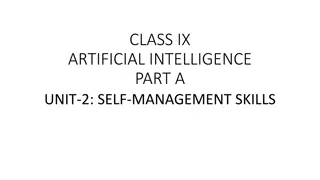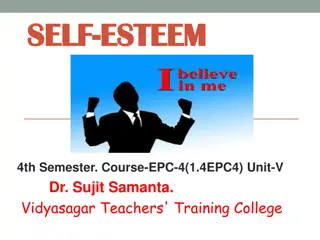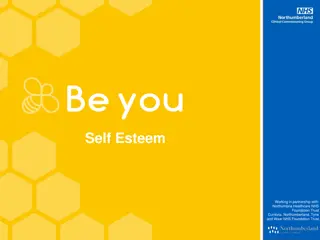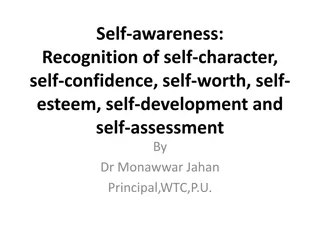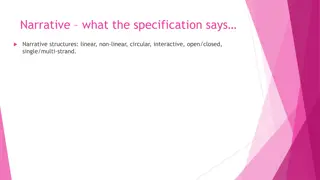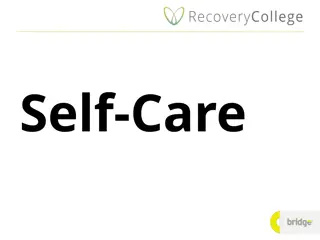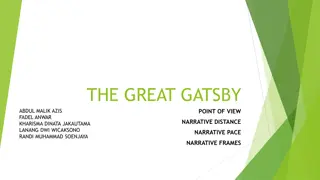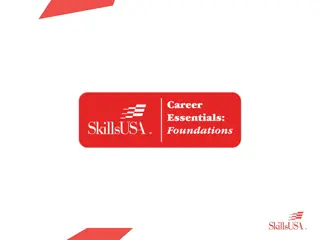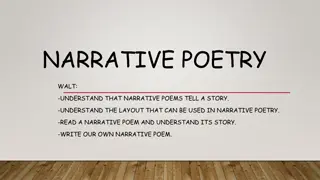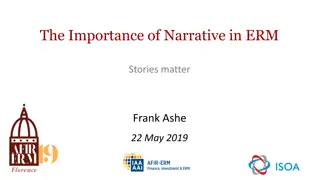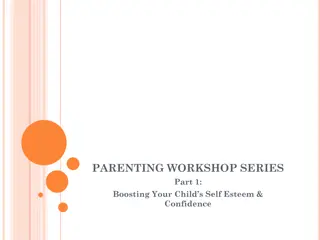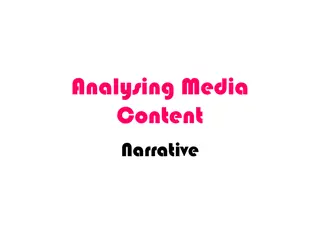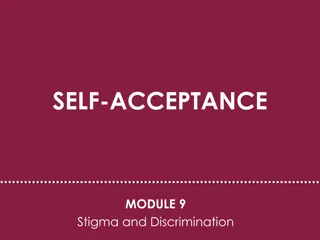Understanding Eudaimonic Growth and the Narrative Self
Delve into how virtues and motives influence the development of the narrative self within a social context. Explore the interplay between eudaimonic values, virtues, and the impact of families and social institutions on personal growth. Discover the significance of narrative self-construction in shaping one's moral identity and the developmental journey towards eudaimonia.
Download Presentation

Please find below an Image/Link to download the presentation.
The content on the website is provided AS IS for your information and personal use only. It may not be sold, licensed, or shared on other websites without obtaining consent from the author. Download presentation by click this link. If you encounter any issues during the download, it is possible that the publisher has removed the file from their server.
E N D
Presentation Transcript
Eudaimonic Growth: How Virtues and Motives Shape the Narrative Self and Its Development within a Social Ecology Jack J. Bauer Peggy DesAutels University of Dayton
Main Questions How do eudaimonic values and virtues serve as motives that shape the development of the narrative self? How do families and social institutions both foster and constrain that development? How should they?
Deep Integration: People Jack Bauer, Ph.D., psychology, P. I. Psychology: Narrative self-identity development, eudaimonic growth, motivation, moral psychology Philosophy: Eudaimonia, East and West Peggy DesAutels, Ph.D., philosophy, co-P. I. Philosophy: Virtue ethics, feminist ethics, philosophy of mind Psychology: Cognitive science and moral psychology
Why the Narrative Self? Narrative self (McAdams, 1993, 2006) How people construct subjectively meaningful construals of themselves and their lives Narrative self is a moral self (Taylor, 1989) Life stories position self and others via themes of motivating values and virtues, endowing persons and actions with meaning (Hermans, 2001) Narrative self development (McLean et al., 2007) Meanings of self & life reinterpreted over time Capacity to construct meaning develops
Why Eudaimonic Growth? Eudaimonia is multifaceted, like personhood Person: Traits, motives, stories (McAdams, 2013) Eudaimonia: Many virtues at each level of person Eudaimonic growth: Capacities for virtues develop over time Plus culture and evolution (Flanagan, 2011; Narvaez, 2008) Whether a mess or a rich tapestry, this all comes together in the methodologically pluralistic study of the narrative self and eudaimonic growth
The Umbrella of Eudaimonia (Philosophy and Psychology, East and West) Wisdom: practical reason, psychosocial maturity, authenticity, self-actualizing, mindfulness, etc. Happiness: satisfaction, fulfillment, meaningfulness Love: compassion, generativity, etc.; harmonious passion, vital engagement, etc. Growth: development of wisdom, happiness, love
Narrative Self & Eudaimonic Growth The Transformative Self (Bauer, 2016) Experiential Growth Themes Deepened or strengthened life experience Reflective Growth Themes Learning, insight; heightened conceptual understanding My wedding I saw an imagined future, I saw an accumulated past it all integrated into a profound order. This [time away together] really strengthened our marriage, as my feelings for him became deeper and more caring. Wisdom/Maturity Happiness/Well-Being (Bauer & McAdams, 2004, 2010; Bauer, McAdams, & Sakaeda, 2004, 2005)
The Social Ecology of the Person (Bronfenbrenner, 1979) Macrosystem Exosystem Mesosystem Microsystem Activities of work, church, school Family Individual Peers Community services Chronosystem Time: Social history and individual development
Cultural Master Narratives of Eudaimonic Growth: Bildungsroman (Bauer, 2016)
Growth in the Margins of the Social Ecology Macrosystem: Cultural master narratives of a good life (McAdams, 2006) Aristotle: Eudaimonia requires leisure and luck Depend on luxury, power, cosmopolitanism (DesAutels, 2009; Hammack, 2008) Exosystem: Social institutions foster or inhibit capabilities for eudaimonic growth (Nussbaum, 1998) Systematic oppression (via gender, SES, ethnicity, etc.) makes eudaimonic growth difficult or impossible (DesAutels & Walker, 2004; DesAutels & Whisnant, 2007; Tessman, 2001)
Family Master Narratives (Microsystem) (Fivush et al., 2010; McLean, in press) Shape life stories, as do cultural master narratives Conduit of cultural values, but contextualized for the family s specific microsystem Family narratives can both counter and contribute to cultural oppression Understudied in both philosophy and psychology
Contributions to Virtue Ethics Non-idealized developmental approach Focus on situations of unequal power relationships, abuse of power, institutional hierarchies, and so on. Identify virtues and moral projects needed to resist oppression and abusive power (Tessman Burdened Virtues, DesAutels Resisting Organizational Power ) Expand the contexts and situations in which virtues are embedded both diachronically and synchronically
Hypotheses & Questions Transformative self eudaimonic growth Hypotheses for specific paths Family stories shape narrative self & development Concordance v. discordance eudaimonic growth Social institutions shape life stories & family stories Concordance v. discordance eudaimonic growth Structure of eudaimonic growth? Non-idealized?
Methodology: Interviews Longitudinal study of adult character development Allows for 2-yr stand-alone study + longer-term analyses Year 1: Life story interviews 100 participants, ages 18 80s Virtues in key life memories, virtue conflicts, virtue projects 2 hours each, plus 1-hour online survey Year 2: Family story interviews 50 (of the 125) with 3-4 family members Virtues in key family memories, virtue conflicts & projects 2 hours each, plus 1-hour online survey of family members Also Year 2: Life story follow-up interviews & surveys
Methodology: Narrative Analysis Transdisciplinary, mixed-methods inquiry into the varieties and degrees of themes of eudaimonic virtues and growth in the narrative self By interdisciplinary team of professors and students Quantitative Coded with established & adapted protocols Coded by multiple researchers for inter-rater reliability Qualitative Critical inquiry: Deductive Grounded theory: Inductive
Methodology: Examples of Non-Narrative Measures Wisdom: 3-dimensional wisdom (Ardelt, 2003); subject-object interview (Kegan, 1982) or ego development (Loevinger, 1976); perspective-taking (Davis, 1980); mindfulness (Brown & Ryan, 2003); authenticity (Wood et al., 2008) Happiness: PWB (Ryff & Keyes, 1995); SWB (Diener et al., 2006) Love: compassion (Hwang et al., 2008); generativity (McAdams & de St. Aubin, 1992); self-compassion (Neff, 2003); harmonious & obsessive passion (Vallerand, 2008) Growth: growth motivation (Bauer et al., 2015); comparisons over time Also: values (Schwartz, 1990); moral foundations (Graham, Haidt, et al., 2011); quiet ego (Wayment, Bauer, & Sylaska, 2014)
Deep Integration: People Matt Montoya, Ph.D., social psychology, consultant Interpersonal and intergroup relations, evolutionary psychology, moral psychology Sociology and biological psychology Jana Bennett, Ph.D., religious studies, consultant Theological ethics, marriage and family ethics, feminism Developmental moral psychology
Deep Integration: People Lucas Keefer, Ph.D., psychology postdoctoral fellow Social/personality psychology of relationships, cultural metaphors in self-identity Lars Bauger, M.A., psychology predoctoral fellow Telemark University, Norway; at UD fall 2015 semester Self & character development, aging, life transitions 2-3 graduate assistants in psychology 10-15 undergrad assistants in psychology & philosophy
Challenges Revising and integrating models of eudaimonia, virtues, and their development Bridging ideal and non-ideal contexts for flourishing Descriptive and normative categorization of virtues Objectivist and subjectivist approaches to the good Links among individual, family, society Counter-narratives to oppressive master narratives Degrees of convergence and conflict in self and family stories Disciplinary frameworks and purposes
Approach to Challenges Ongoing discussion of our aims and approaches Method: Collaborative narrative analysis Results: Directly compare and contrast quantitative and qualitative assessments Transdisciplinary publications and presentations Book on this study Articles, chapters(e.g., Bauer & DesAutels, 2015)
Subjective & Objective Measures of the good (Bauer, 2016)


